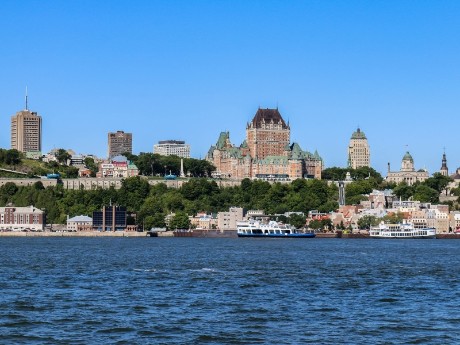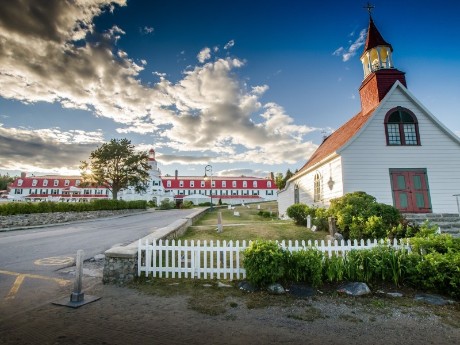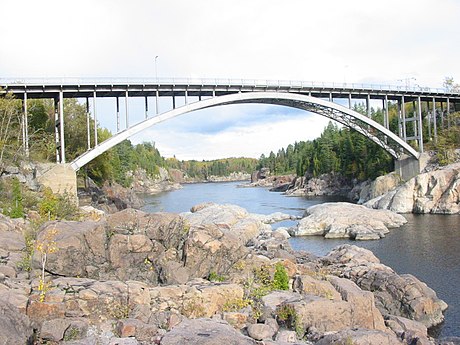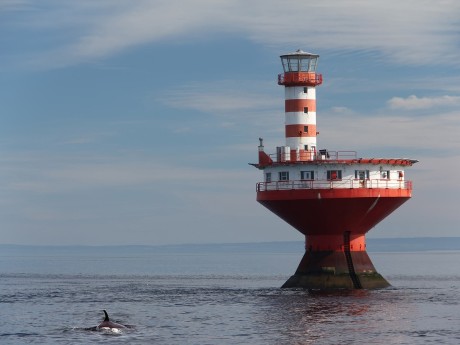Canada: Quebec City, Tadoussac & Saguenay
Discover the enchanting allure of Quebec's culture, history, and scenery. Stroll along cobblestone streets, admire the historic architecture, and explore iconic landmarks including Old Quebec, a UNESCO World Heritage site, where you can explore the impressive Place Royale and Citadelle of Quebec. Venture beyond the city walls to Montmorency Falls, a natural wonder taller than Niagara Falls.
Read more
Discover the enchanting allure of Quebec's culture, history, and scenery. Stroll along cobblestone streets, admire the historic architecture, and explore iconic landmarks including Old Quebec, a UNESCO World Heritage site, where you can explore the impressive Place Royale and Citadelle of Quebec. Venture beyond the city walls to Montmorency Falls, a natural wonder taller than Niagara Falls. Don't forget to explore the Plains of Abraham (Battlefields Park), an expansive urban park with a historical significance, and fully immerse yourself in Quebec's rich culture by visiting the Museum of Civilization, before dropping by restaurants in the city for a traditional Quebecois meal. Your next stop is Tadoussac, which lies at the intersection of the St Lawrence and Saguenay rivers. Embark on a boat tour to witness the majestic marine life, especially the whales! Lastly, in Saguenay, visit fascinating museums and see breathtaking fjords and river views. Surround yourself by the natural beauty of various parks and venture out on several outdoor activities. Waterviews strives to offer accommodation options within walking distance of water and/or in an area of touristic interest. Our prices include taxes (but excludes local tourist taxes). Customize your trip to your personal preferences with optional activities (hit the “Add Activities’’) or change hotels, etc. Contact us for customization at no extra cost at: Service@waterviewstravel.com
Destinations
- Quebec City
- Tadoussac
- Chicoutimi-Jonquière
Itinerary
Quebec City

Settled on cliffs overlooking the St. Lawrence Seaway is Quebec City, a UNESCO World Heritage Site and the capital of Canada’s Quebec Province. Its colonial centre features winding cobblestone streets lined with bistros and boutiques, magnificent architecture dating from the 1600s, and is topped by the spectacular Château Frontenac. Quebec City mixes its history with modernity and hosts a wide range of cultural events including an incredible winter festival.
Read more
Settled on cliffs overlooking the St. Lawrence Seaway is Quebec City, a UNESCO World Heritage Site and the capital of Canada’s Quebec Province. Its colonial centre features winding cobblestone streets lined with bistros and boutiques, magnificent architecture dating from the 1600s, and is topped by the spectacular Château Frontenac. Quebec City mixes its history with modernity and hosts a wide range of cultural events including an incredible winter festival.
Additional Information
Quebec City is referred to as the National Capital in the province. Much of the business here is of the administrative and bureaucratic nature, which would normally make a city quite dull. Fortunately, the city has a remarkable history, as the fortress capital of New France since the 16th century. Although the town's day-to-day life leaves things a little yawny at times, the vibrant historical centre makes for an incredible visit.
Quebec was first settled by Europeans in 1608 in an "Habitation" led by Samuel de Champlain, and celebrated its 400th anniversary in 2008. The generally accepted dates of Champlain's arrival in the city, July 3rd and 4th, were marked with major celebrations. The area was also inhabited by Native peoples for many centuries before the arrival of the Europeans, and their ongoing presence has been notable since then.
When it was founded by the French to make a claim in the New World, the name Quebec referred to just the city. It is an Aboriginal word for "where the river narrows" as the St. Lawrence River dramatically closes in just east of the city. It rests on 65-m-high (200-foot) cliffs with stunning views of the surrounding Laurentian Mountains and the St. Lawrence River. Under French rule from 1608 to 1759, the major industries were the fur and lumber trades. The French lost the city and the whole colony of New France to the British in the Battle of the Plains of Abraham in 1759. Much of the French nobility returned to France, and the British assumed rule over the remaining French population. The rulers of the colony allowed the French to retain their language and religion, leaving much of the culture intact. In the 1840s, there was an influx of Irish immigrants during the Potato Famine. Due to cholera and typhus outbreaks, ships were quarantined at Grosse Isle to the east of the city past l'Île d'Orléans. The bodies of those who perished on the journey and while in quarantine are buried there. The city remained under British rule until 1867 when Canada West (Quebec) and Canada East (Ontario) joined New Brunswick and Nova Scotia to form the Dominion of Canada.
French is the official language of the province of Quebec though in the tourist areas of Quebec City, English is widely spoken as a second language by almost all of the staff. It is also not unusual to find Spanish, German and Japanese spoken in many establishments in Vieux-Quebec. Outside of the tourist areas, some knowledge of French is advisable and perhaps necessary, depending on how rural the area is. While older locals struggle when attempting to sustain a discussion in English, most people under 35 should be able to speak conversational English. Less than a third of the overall population is bilingual French/English.
In French, both the city and the province are referred to as Québec. Context determines the difference. By convention, the province is referred to with masculine articles (le Québec, du Québec, or au Québec), and the city takes no article at all (de Québec, à Québec). Provincial road signs and other official signage refer to Quebec City as simply Québec.
Quebec City was named the 5th best city destination in North America and 10th in the world in 2010 by Condé Nast Traveler, and best Canadian city for culture, 4th best Canadian destination, and 7th most romantic city in the world in 2010 by TripAdvisor.
Climate
Quebec has a humid continental climate, meaning there's considerable temperature variation over the year. Winters are cold with temperatures below -20°C certainly not unheard of (for a comparison to European destinations, the winter temperature range is comparable to Rovaniemi at the Arctic Circle while Quebec is at the same latitude as Central France!), with strong winds amplifying the cold temperature, and often also much snow.
Summer daytime temperatures are often just above +20°C, though it can get considerably hotter. Spring and fall tend to be rather short transition periods, and periods of warm weather far into the fall are common.
Orientation
Orienting yourself in Quebec is fairly easy. Many sights of interest are in the Old Town (Vieux-Québec), which constitutes the walled city on top of the hill. Many surrounding neighbourhoods, either in Haute-Ville ("Upper Town") or in Basse-Ville ("Lower Town"), are of great interest: Saint-Roch, Saint-Jean-Baptiste, Montcalm, Vieux-Port and Limoilou. Haute-Ville and Basse-Ville are connected by many staircases, all of which are unique, such as the aptly-named Escalier Casse-Cou ("Breakneck Stairs") and the more easily climbable "Funiculaire".
The city spreads westward from the St. Lawrence River, for the most part extending from the old city. The true downtown core of Quebec City is just west of the old city. Across the river from Quebec City is the town of Lévis. Frequent ferry service connects the two sides of the river.
Visitor information
© Sourced from Wikivoyage
Tadoussac

Located at the mouth of the Saguenay River is the small town of Tadoussac, a paradise for nature lovers. Each year, visitors flock to the town to observe the many whales that appear on the river, as well as other sea mammals which can be spotted from the coast. The town is also a great spot for adventure sports and activities such as kayaking, hiking, sailing and walking in the surrounding nature.
Read more
Located at the mouth of the Saguenay River is the small town of Tadoussac, a paradise for nature lovers. Each year, visitors flock to the town to observe the many whales that appear on the river, as well as other sea mammals which can be spotted from the coast. The town is also a great spot for adventure sports and activities such as kayaking, hiking, sailing and walking in the surrounding nature.
Additional Information
Tadoussac, which started as a trading post, is the oldest still existing French settlement in the western hemisphere. Explorer Jacques Cartier visited the area in 1535, followed by Pierre de Chauvin in 1599 and Samuel de Champlain in 1603. The first official fur trade post in Canada was established in 1600; the village (which celebrated its 400th birthday in 2000) boasts of many homes more than a century old.
A small village hidden in a mountain valley, Tadoussac occupies a privileged position at the maritime crossroads of the Saguenay fjord and the majestic St. Lawrence river, with sand dunes and a small lake in the heart of the village.
© Sourced from Wikivoyage
Chicoutimi-Jonquière

Chicoutimi and Jonquière are communities in the city of Saguenay (145,000 inhabitants in 2011) in the Saguenay-Lac-Saint-Jean region of Québec.
Read more
Chicoutimi and Jonquière are communities in the city of Saguenay (145,000 inhabitants in 2011) in the Saguenay-Lac-Saint-Jean region of Québec.
Additional Information
Chicoutimi and Jonquière are former cities in the Saguenay region of Quebec which (with Bagotville, Ville de la Baie and other surrounding towns) were merged in 2002 into one municipality named "Saguenay" for the Saguenay River.
The region is strongly unilingual francophone; principal local industries have historically been forestry, paper (Abitibi, Price, Stone-Consolidated) and aluminium smelting (Alcan). CFB Bagotville is the local air force base; a community college (Collège de Jonquière) offers an intensive three-week immersion programme in French as a second language which has long attracted civil servants from the nation's capital and draws students from as far as New Brunswick.
Chicoutimi-Jonquière is geographically isolated as the 2½ hours of four-lane road leading into the municipality from Québec City runs almost entirely on provincial parkland with just one opportunity to stop for fuel at the midpoint. There is cellular telephone service on the main road in, but along many other roads (such as Chicoutimi-Nord to Tadoussac) there is truly nothing.
© Sourced from Wikivoyage





